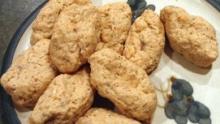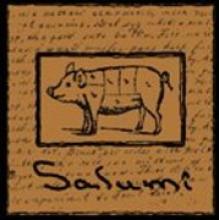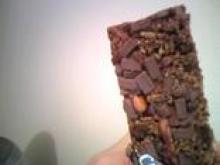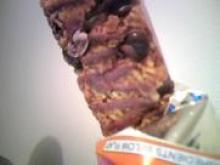The only fresh sweet cherries we ever got in New England were Bing cherries. But the Northwest is very very lucky; cherries grow well in Washington, Oregon, Idaho, and Montana. The growing season starts around the first week of June, and, depending on the state and the variety of cherry, lasts until late August. Moreover, since cherries are more durable than, say, raspberries, they can be picked at the perfect point of ripeness, and shipped to grocers in about two days. Fortunately, the Northwest is also wealthy in terms of "you pick" farms, and local farmers' markets where local growers bring their just picked cherries to you.
Technically, cherries are members of the Rosaceae, family, genus Prunus, and thus cousins to almonds, apricots, peaches, plums, and bird cherries. The cherries I'll be writing about today are "sweet" cherries, or Prunus avium, which do not require cooking, unlike "sour" cherries, which usually do require cooking, and in America, are mostly grown in Michigan. There are a lot more varieties of cherries available in the Northwest than the Bings I grew up eating. Washington state produces about 40% of the USA's sweet cherries (55% of those are consumed "as is," as fresh fruit) annually. Washington exports about 25% of its cherry crop every year; primarily to Asian markets.
In Washington, the cherry trees start to erupt into bloom in April. Orchard owners place rented beehives in the orchards and hope for successful pollination, and that the buds don't get damaged by a late spring frost. That may mean waking in the pre-dawn and very chilly hours and checking on trees, lighting smudge pots to provide heat near them, and even setting up fans and wind machines to keep the warm air from the smudge pots circulating. Most modern cherries can't self-pollinate, which means any cherry orchard has to have a second variety of cherry mixed in at regular intervals for pollination. Researchers at Washington State University started breeding and hybridizing sweet cherries roughly fifty years ago. The first cherry varieties were Rainier, and Chinook, the work of Harold Fogle. Shortly after, Tom Toyama bred and Ed Proebsting released a number of other varieties, many of which (Chelan, Olympus and Cashmere) still widely grown today, though Chelan is the most commercial of the three, and most likely to be seen at a grocers in the Northwest; growers are deliberately introducing it as an alternative to Bing cherries, because they share many qualities but Chelan ripens earlier. The Rainier is the premier American export cherry to Asian markets.
The first cherries to ripen are usually the Chelans. The Chelan is a very dark red, almost heart-shaped cherry. The Chelan was developed in Prosser, WA, though it also does well in Oregon. Tieton ripens next; it tends to be a strikingly large cherry, closer to the traditional "cherry" red, and a mild but distinctively sweet flavor. A week or so later, the Bing cherry usually ripens; this is the familiar dark mahogany cherry that is grown in the Northwest and shipped all over the world. Bing cherries are the leading commercially grown cherry in the United States. The next cherry to ripen is the Rainier, one of my very favorites. When Rainier's arrive in Southern California markets people call each other up to say "The Rainier's are in." These are a bi-color cherry, predominantly yellow with a bright scarlet blush. The flesh is yellow but very sweet with a slightly different flavor than any other cherry. They are a little delicate, and don't last long; more than any other cherry, these should be purchased and enjoyed as soon as possible; you might not find them a week later. There are other varieties—Lapins, a dark red, and slightly elongated cherry, and two varieties that are very late July and August cherries; Skeena, a very dark almost black red, that's usually described as "dense" but sweet, and Sweethearts, which I'm told are often mistakenly identified as Bing cherries, but more heart-shaped, and slightly firmer. I've yet to try Skeena or Sweethearts.
In Washington, most cherries are grown in the eastern half of the state, in Yakima and Wenatchee. There are a number of farms offering roadside stand sales and "pick your own" cherries. One of the largest cherry farms in Washington's Yakima valley is Barrett's Orchards. Olmstead Orchards offers Internet and phone ordering for cherries delivered to your door. Your best best for fresh cherries is to keep a close eye on your grocer's produce section and local farmer's markets. Buy them when you see them and plan to use the cherries in two or three days at most.
Keeping in mind that sweet cherries are at their best when they are fresh, and that most of the time people simply want to eat them, there are a number of dishes you can make with fresh sweet cherries. One of my very favorite ways to use them is to brandy them, and then give the brandied cherries away as holiday gifts in December. I've found that Rainier's alone don't really work as well as the darker sweet cherry varieties. Chelans and Lapins work quite well. You want to use the freshest cherries you can, and the best quality brandy you can; Christian Brothers Brandy, at the very least. If you wouldn't drink the brandy, you shouldn't use it to cook with. You might try the recipe as is first, but many people add spices to their syrup; cloves, are very popular. I like to split a vanilla bean the long way, scrape the center, chop the bean up, and add all of it to the syrup mixture just before I turn off the heat.
Brandied Cherries
Ingredients
- 6 pounds fresh sweet cherries
- 6 glass ping canning jars
- 1-1/2 cups sugar
- 1-1/3 cups water
- 2 tablespoons fresh lemon juice
- 1-1/2 cups brandy
Procedure
- Wash, stem and pit cherries.
- Sterilize 6 pint jars and lids for a boiling water bath.
- Combine the sugar, water and lemon juice in a saucepan.
- Boil, stirring gently until the sugar is completely dissolved, then remove from heat.
- pour 1/4 cup of the hot syrup over cherries that are tightly packed to about an inch of top of the freshly sterilized hot jars.
- Add 1/4 cup or so of the brandy, and more syrup if necessary to each jar so that the cherries are covered.
- Gently shake the open jar to release any air bubbles then wipe the jar rim with a clean damp cloth to remove any sticky syrup residue.
- Close each jar tightly with the lid.
- Process the jars in a boiling water bath for 20 minutes. (Follow the manufacturer's instructions for the proper canning procedure.)
Brandied cherries are lovely over vanilla ice cream, or warm fudgey brownies, or chocolate cake, or used as flambé, or added to a winter mix of dried stewed fruit. The dark red of the cherries looks lovely in the jars, and the brandy-and-syrup mixture is a wonderful flavoring on its own. You need to let the cherries "set" for a while, at least a few weeks, before trying them. They make a lovely holiday present; just stick a ribbon on the lid and you're good to go.




